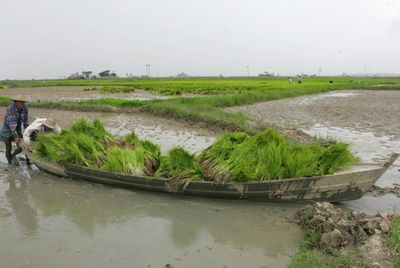Myanmar cyclone survivors rush to plant against long odds

THOME GWE, Myanmar – Ko Nyi Thaut lost six of his children and all his possessions when Cyclone Nargis hit Myanmar three months ago. But the 53-year-old farmer still has his rice fields. The surprise, say aid workers, is how quickly he and others have gone back to work.
The broader food outlook, however, is bleak.
Like tens of thousands of farmers, Ko Nyi Thaut labors from dawn to dusk preparing his flood-ravaged Irrawaddy delta land for a crop that should have been planted a month ago.
“If the weather is good and we are lucky, I think we could get about two-thirds of what we had before,” he said.
“It would not have been enough for my family if we still had 11 people. But the cyclone killed six of my children, so maybe we will have enough rice for the family now.”
His remark is a reminder of how the cyclone ripped families to shreds as it roared through the delta May 2-3, killing 84,537 and leaving 53,836 missing and presumed dead, according to an official count.
Now comes the task of feeding the survivors, and aid workers acknowledge the odds are stacked against them being able to match the bountiful yields that turned this region into Myanmar’s rice bowl.
Many farmers have been quickly draining their land and removing fallen trees and other debris. But they say they lack water buffaloes and plows or have gone heavily into debt to buy fuel that has doubled in price. Families have lost not just their land but the fathers and sons who knew how to farm it.
“It doesn’t look good at all,” said Ashley Clements, of the World Vision aid group, by telephone from Myanmar. Many people will need food aid for “for the next few months and even for a year or so.”
In the cyclone’s immediate aftermath, the focus was on feeding and sheltering the estimated 2.4 million survivors.
Now the recovery effort turns to reviving livelihoods. It will be a tall task considering that 2 million acres of rice paddy were submerged by the massive waves and 85 percent of seed stocks destroyed.
Experts said returning farmers to the fields is a priority because of the threat of worsening food shortages. In 1988, demonstrations against Myanmar’s military junta because of rice prices and other issues ended in heavy bloodshed.
The U.N.’s World Food Program has provided 20,000 tons of food aid to 733,000 cyclone survivors and sees the number in need growing to 924,000. But even after the rice is harvested in October, it expects to continue feeding as many as 300,000 survivors for another year.
“Normally, we try to avoid giving out food at harvest time,” said Tony Banbury, the WFP regional director in Bangkok. But this time it’s different because of the loss of animals, land or a family head who “may have left behind a wife and four kids but she doesn’t have the skills to immediately pick up farming.”
Myanmar officials say only about 30 percent of affected fields have been planted, while the U.N. Food and Agriculture Organization acknowledged that 75 percent of farmers lack sufficient seed, with little time left before the planting season ends in August.
The FAO’s Mona Chaya in Myanmar expects yields to be down 20 percent from previous years. “It will take at least two more seasons with proper inputs to get the rice production back to normal in the delta,” she said in an e-mail interview.
Many fields are empty, flooded or littered with yellow rice shoots killed by salty water.
Nyunt Wai, a 53-year-old from the village War Yone Sake, angrily ticked off the woes that are slowing efforts to replant his fields: no money for fertilizer, fields still stained with salt water, crabs washed in from the storm that eat his rice seeds.
“We have to start from zero again,” he said. “I don’t expect any help from the government. They are helpless.”
Ko Nyi Thaut said he is driven by the imperative of feeding what’s left of his family.
“My wife and my three surviving children are all I have now,” he said. “I won’t let them die of starvation … If I miss this season, they will not have rice for another year.”